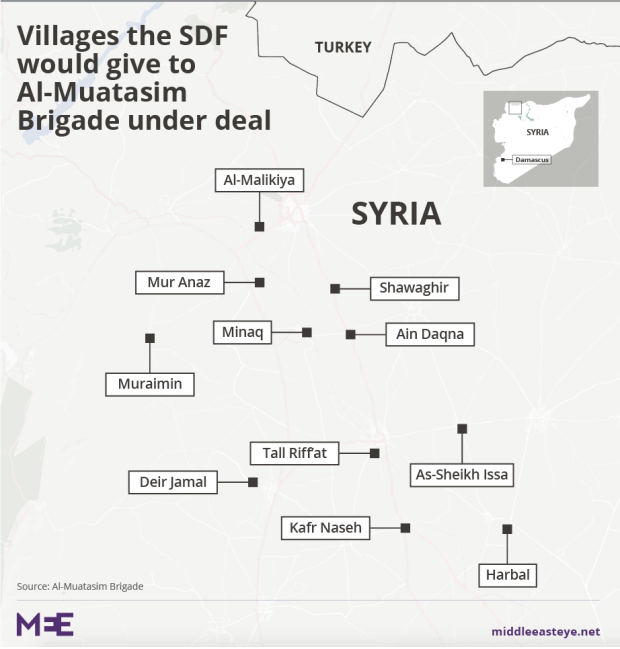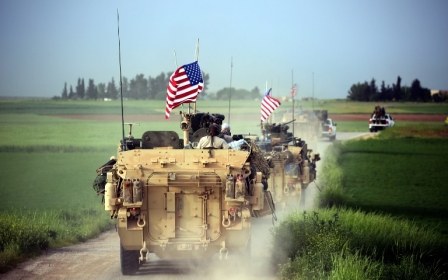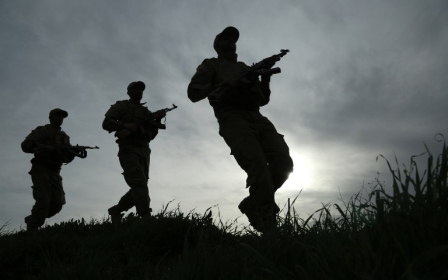The deal between Syrian Arabs and Kurds that could be the way forward in northern Syria

Earlier this month, Al-Muatasim Brigade, a Free Syrian Army faction (FSA) backed by the US, announced that it had reached an unprecedented agreement with its rival, the Syrian Democratic Forces (SDF), a Kurdish-led, multi-ethnic coalition sponsored by the US to fight the Islamic State (IS) group.
As part of the deal that was initiated and brokered by the US-led coalition, Al-Mutasim Brigade would take over 11 villages in northern Syria, now controlled by the SDF. It's not clear yet what the SDF would get in return.
Sources have told me that while the outlines of the agreement have been reached, the parties have yet to formally sign on as details are still being worked out. The SDF and US have yet to comment publicly on the deal.
Many analysts see this US-led initiative as an attempt to mitigate tensions between Syrian Arabs and Kurds. But they disagree on how successful it could be.According to earlier leaks about this agreement, published last month, the negotiations started around mid-March, but the talks fell apart after there were disputes over the number of designated villages, and how and when the SDF would withdraw.
The inability to reach an agreement at that point led to a limited rounds of clashes in the disputed areas.
The recent breakthrough was reached by the negotiating parties under three main conditions:
1) Weapons in the designated villages will be confined to members of Al-Muatasim Brigade.
2) Local civilians, including unarmed FSA personnel, can return to their homes.
3) Kurdish civilians can enter and reside in these villages.
Overall, the agreement would allow tens of thousands of displaced Syrians to go back to their villages.
Avoiding secondary conflict
More broadly, the agreement aims to mitigate tensions between Turkey, Syrian Arabs and Kurds.
The SDF captured the villages included in the agreement from rebel forces in February 2016 during an offensive led by the Syrian regime against rebel groups in northern Syria.
'The main reason behind this agreement is to avoid a secondary conflict between Arabs and Kurds, which will be disastrous for all sides'
-Mustafa Sejari, of al-Muatasim Brigade
Many Syrian Arabs saw the SDF’s attack on rebel-held areas as a sign that the US-backed forces were acting as an ally of the Syrian regime and also interpreted the offensive as a Kurdish pretext to take advantage of US support and expand their territories in areas where Arabs are a majority.
But the Kurdish groups also mistrust the Syrian rebels whom they perceive as an existential threat because of their affiliation with Turkey which has armed some rebel groups.
So the agreement needed a broker to mediate tensions between the Syrian Kurds and Arabs, and the US stepped in.
“The main reason behind this agreement is to avoid a secondary conflict between Arabs and Kurds, which will be disastrous for all sides,” Mustafa Sejari, the head of the Political Office of al-Muatasim Brigade told me on Thursday, 9 May.
“Such peace should start with confidence building measures that allow people to go back to their homes.”
'Too little, too late'
Some Syrian analysts expressed their support for the agreement, but their expectations of how effective – and lasting – it will be if it is implemented are limited.
“This agreement is too little, too late... tension between Arabs and Kurds reached a level where confrontations seem inevitable,” said Syrian Journalist Manhal Barish.
Other Syrian analysts think that it can improve Kurdish-Arab relations in the villages where it is implemented.
“This agreement can have a positive impact on relations between Arabs and Kurds but that could only happen if it is implemented correctly,” said Assaad al-Achi, a Syrian civil society activist and executive director of Baytna Syria, an Gaziantep-based NGO.
“That said, its positive impact is likely to be limited to the areas included in the agreement.”
Unlikely to de-escalate Turkish tensions
There is also a general assumption that the agreement aims to mitigate tension with Turkey, which views the autonomous Kurdish-led region along its border with northern Syria - essentially ruled by the PYD, a party with close ties to the PKK - as a threat.
“The main aim of this agreement could be seen as part of the US "tactical" policy to reduce tension and create buffer zones between the SDF and Turkey,” said Obaydah Amer, a political editor the Midan website.
Although the negotiations have been ongoing for months now, the timing of the agreement right after the US decision to arm the Peoples' Protection Units (YPG) within the SDF lends credence to this assumption.
But the analysts I spoke to agree that this move alone is unlikely to de-escalate tensions between Turkey and its neighbours, especially given that Al-Muatasim Brigade is known to be a strong ally of the US, not Turkey - which is why the US chose the group to be in charge of the designated villages.
Al-Muatasim Brigade believes, nonetheless, that Turkey will not try to spoil the agreement. “Turkey was not directly involved in the negotiations, but I do not think that it will be against it,” said Sejari.
It is still not clear whether this agreement will be implemented as the final draft of the accord has not been signed by all parties. “The agreement was mysteriously leaked in an attempt to spoil it. But we are determined to make it work,” Sejari said.
- Haid Haid is a Syrian columnist and researcher and a Chatham House Associate Fellow. Focus: Security policy, conflict resolution, Kurds and Islamist movements. He tweets @HaidHaid22.
The views expressed in this article belong to the author and do not necessarily reflect the editorial policy of Middle East Eye.
Photo: Members of the Syrian Democratic Forces (SDF), made up of US-backed Kurdish and Arab fighters, ride in an armoured vehicle near the village of Bir Fawaz, 20 km north of Raqqa, during their offensive towards the Islamic State (IS) group's Syrian stronghold in February 2017. (AFP)
New MEE newsletter: Jerusalem Dispatch
Sign up to get the latest insights and analysis on Israel-Palestine, alongside Turkey Unpacked and other MEE newsletters
Middle East Eye delivers independent and unrivalled coverage and analysis of the Middle East, North Africa and beyond. To learn more about republishing this content and the associated fees, please fill out this form. More about MEE can be found here.






